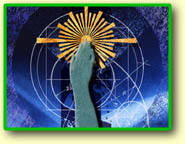The Universe
as a hologram
Does Objective Reality Exist, or is the Universe a
Phantasm?
In 1982 a remarkable
event took place. At the University of Paris a research team led by physicist Alain Aspect
performed what may turn out to be one of the most important experiments of the 20th
century. You did not hear about it on the evening news. In fact, unless you
are in the habit of reading scientific journals you probably have never even heard
Aspect's name, though there are some who believe his discovery may change the face of
science. You did not hear about it on the evening news. In fact, unless you
are in the habit of reading scientific journals you probably have never even heard
Aspect's name, though there are some who believe his discovery may change the face of
science.
Aspect and his team
discovered that under certain circumstances subatomic particles such as electrons are able
to instantaneously communicate with each other regardless of the distance separating them.
It doesn't matter whether they are 10 feet or 10 billion miles apart. Somehow each
particle always seems to know what the other is doing. The problem with this feat is that
it violates Einstein's long-held tenet that no communication can travel faster than the
speed of light. Since traveling faster than the speed of light is tantamount to breaking
the time barrier, this daunting prospect has caused some physicists to try to come up with
elaborate ways to explain away Aspect's findings. But it has inspired others to offer even
more radical explanations.
University of London
physicist David Bohm, for example, believes Aspect's findings imply that objective reality
does not exist, that despite its apparent solidity the universe is at heart a phantasm, a
gigantic and splendidly detailed hologram.
To understand why Bohm
makes this startling assertion, one must first understand a little about holograms. A
hologram is a three- dimensional photograph made with the aid of a laser.
To make a hologram, the
object to be photographed is first bathed in the light of a laser beam. Then a second
laser beam is bounced off the reflected light of the first and the resulting interference
pattern (the area where the two laser beams commingle) is captured on film. When the film
is developed, it looks like a meaningless swirl of light and dark lines. But as soon as
the developed film is illuminated by another laser beam, a three-dimensional image of the
original object appears.
The
three-dimensionality of such images is not the only remarkable characteristic of
holograms. If a hologram of a rose is cut in half and then illuminated by a laser, each
half will still be found to contain the entire image of the rose. Indeed, even if the
halves are divided again, each snippet of film will always be found to contain a smaller
but intact version of the original image. Unlike normal photographs, every part of a
hologram contains all the information possessed by the whole.
The "whole in
every part" nature of a hologram provides us with an entirely new way of
understanding organization and order. For most of its history, Western science has labored
under the bias that the best way to understand a physical phenomenon, whether a frog or an
atom, is to dissect it and study its respective parts. A hologram teaches us that some
things in the universe may not lend themselves to this approach. If we try to take apart
something constructed holographically, we will not get the pieces of which it is made, we
will only get smaller wholes.
This insight suggested
to Bohm another way of understanding Aspect's discovery. Bohm believes the reason
subatomic particles are able to remain in contact with one another regardless of the
distance separating them is not because they are sending some sort of mysterious signal
back and forth, but because their separateness is an illusion. He argues that at some
deeper level of reality such particles are not individual entities, but are actually
extensions of the same fundamental something.-->
|





